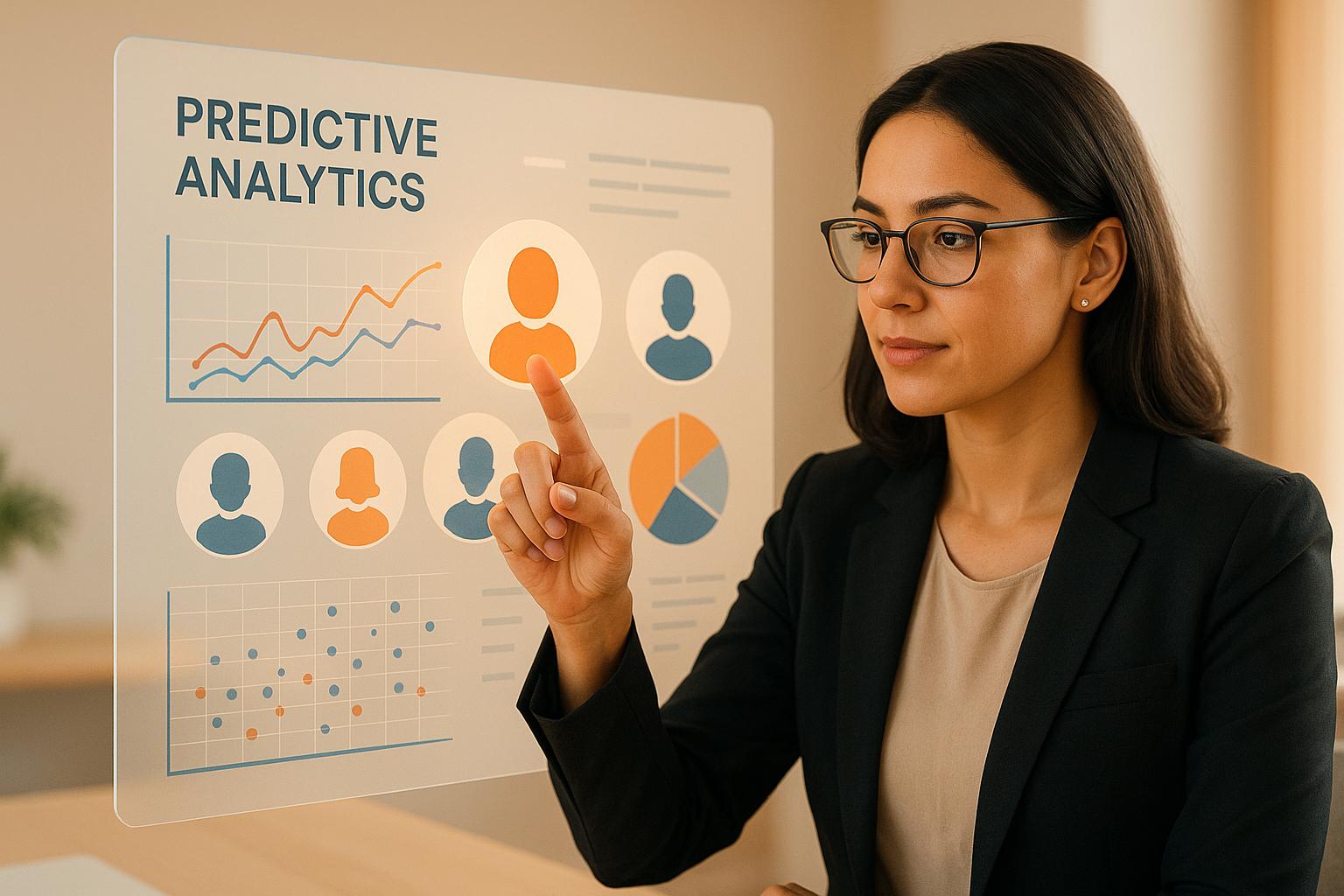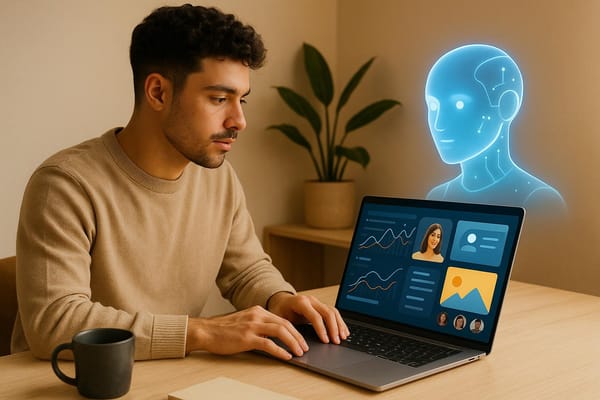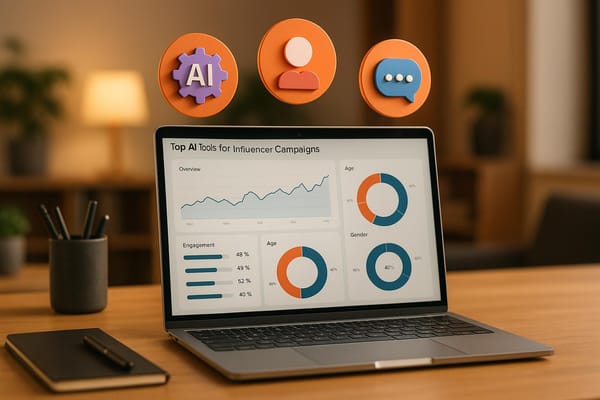How AI Improves Creator Campaign Targeting
Explore how AI enhances influencer marketing through smarter targeting, fraud detection, and campaign optimization, driving better ROI for brands.
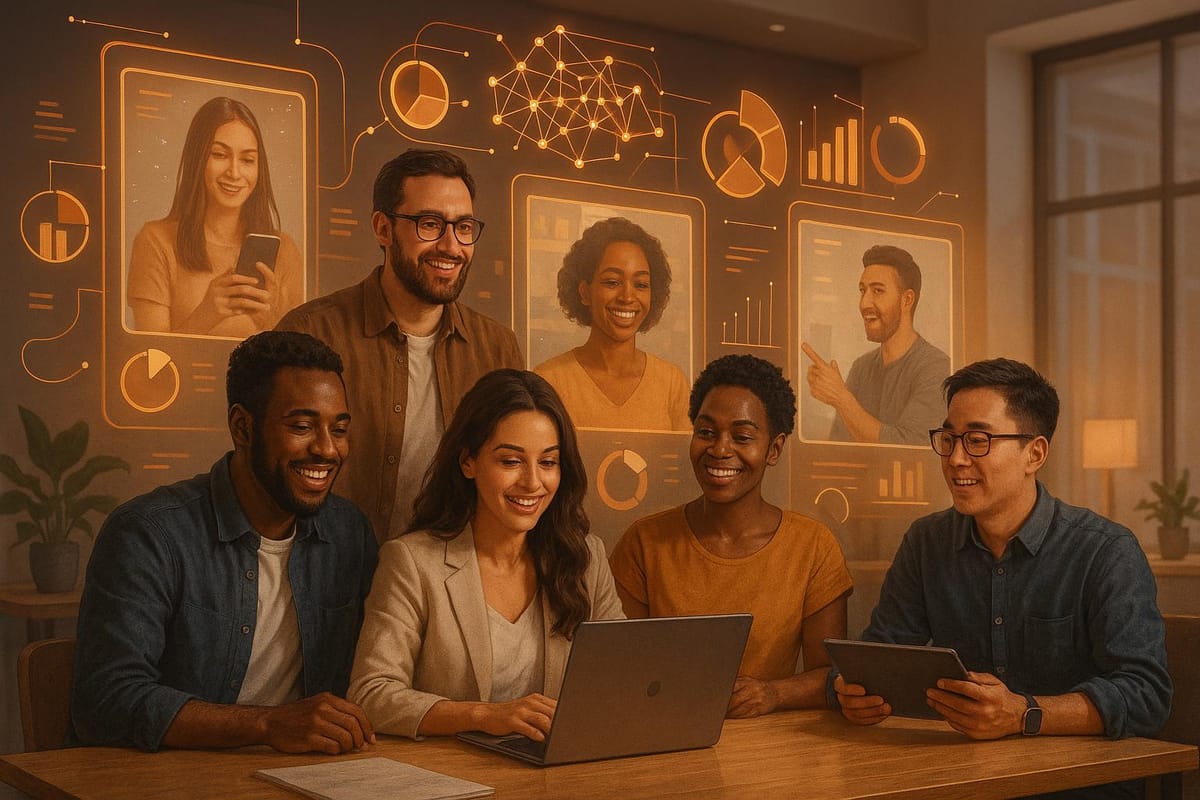
AI is reshaping how brands run influencer campaigns, focusing on data-driven decisions instead of outdated popularity metrics. By analyzing audience behaviors, engagement trends, and demographics, AI ensures brands work with creators who align with their goals. This shift enhances campaign performance, saves time, and boosts ROI.
Key Takeaways:
- Personalization Matters: 71% of consumers expect tailored interactions, and AI helps deliver them.
- Smarter Creator Selection: AI matches brands with creators based on data, not just follower counts.
- Fraud Detection: AI identifies fake followers and ensures real engagement.
- Time Savings: Automating repetitive tasks can save PR teams up to 40 hours weekly.
- Predictive Analytics: AI forecasts campaign outcomes and optimizes content for better results.
- Boosted ROI: AI-driven campaigns can increase conversions by up to 20%.
AI tools like Media AI streamline creator targeting by offering detailed databases, fraud detection, and predictive insights, making influencer marketing more effective and efficient.
How This PR Agency Predicts Influencer Success with AI
AI-Powered Creator and Audience Analysis
AI is revolutionizing how brands identify and evaluate creators by processing massive amounts of campaign data in seconds. This rapid analysis helps pinpoint the best creator matches based on past performance, audience demographics, and engagement trends. The result? A perfect alignment between creators and campaign goals.
Matching Creators with Campaign Goals
AI dives deep into creator profiles, analyzing everything from audience behavior to content themes and engagement quality. It evaluates how well an influencer aligns with a brand’s values and target audience, using historical data to predict future performance.
Take this example: A fashion brand analyzed 18 months of data with AI and uncovered an 8% customer segment responsible for 22% of revenue, with conversion rates 47% higher than average.
"Influencer marketing has always come with a level of uncertainty... Predictive analytics is changing that. By turning historical campaign data into forward-looking insights, AI tools help marketers move from guesswork to strategy." – Lynne Clement
The data makes a strong case for precision targeting. Brands that use segmentation are 130% more likely to understand their customers' motivations, and targeted ads are twice as effective in driving sales. It's no wonder 24% of marketers already rely on AI for audience segmentation.
But AI isn’t just about matching creators; it also ensures campaign authenticity by tackling fake engagement.
Finding Fake Followers and Ensuring Real Engagement
Fake followers remain a major issue in influencer marketing. Nearly half (49%) of Instagram influencers are estimated to have used fake followers, costing brands $1.3 billion since 2019. Additionally, up to 20% of an influencer’s followers may be fake, making fraud detection a top priority for marketers.
AI steps in by using machine learning to detect red flags like sudden follower spikes, bot-like comments, and unusually low engagement rates. This technology helps brands separate genuine interactions from automated ones .
Levi’s is a great example of AI’s impact. After switching to an AI-powered platform, the company reduced outreach time by 70% and boosted ROI by 30%.
Beyond improving targeting and engagement, AI also saves PR teams a significant amount of time.
Time-Saving Benefits for PR Teams
AI-powered tools drastically cut down the time spent on influencer research. What used to take hours of manual effort can now be done in real-time, with AI delivering accurate matches and actionable insights. In fact, these platforms can save PR teams up to 40 hours a week by automating tasks like influencer discovery, fraud detection, performance tracking, and content scheduling .
For example, a mid-sized digital publisher used an AI tool to analyze behavior across 50,000 articles. The system identified a niche group of "Deep-dive professionals" - readers who engaged with long-form industry content early in the morning, shared articles on LinkedIn, and loved data visualizations. Although this group made up just 6% of their audience, they drove 35% of subscription revenue. Armed with these insights, the publisher launched a morning briefing series and optimized their mobile experience, leading to a 3.2x increase in subscription conversions.
Similarly, gaming marketplace Kinguin used AI to grow its ambassador network by 600% in just three months.
The benefits of AI are clear. A survey found that 63% of marketers plan to integrate AI into their influencer campaigns, and 71% believe it will enhance campaign effectiveness. With influencer marketing delivering an ROI of up to $6.50 for every dollar spent, AI-powered automation is proving to be a game-changer. By taking over the heavy lifting of data analysis and screening, AI allows PR teams to focus on strategy and building meaningful relationships.
Predictive Analytics and Campaign Optimization
AI's ability to match creators to campaign goals has taken a leap forward with predictive analytics, refining how campaigns are planned and executed. By analyzing historical and real-time data, AI can forecast campaign outcomes with incredible precision. This shift to data-driven decision-making is already making waves - 30% of agencies, brands, and publishers have fully integrated AI into their media campaign workflows.
AI systems process enormous amounts of historical data to uncover patterns, examining factors like engagement rates, audience demographics, seasonal trends, and competitor performance. These insights allow marketers to predict campaign success before even launching.
Predicting Campaign Performance
AI combines past data with real-time signals to forecast results, from engagement rates to conversion potential, all before any budget is spent. It evaluates audience behavior, content effectiveness, timing, and market trends to provide actionable insights. For instance, companies using data-driven attribution models have reported marketing efficiency gains of up to 30%.
Take Booking.com as an example: their AI-driven predictive modeling led to a 65.16% increase in cart additions, a 73.72% boost in conversions, and a 16.15% rise in average spending.
"The future of paid advertising lies not in reaching more people, but in reaching exactly the right people with exactly the right message at exactly the right time. AI makes this level of precision possible." – Eric Siu, CEO of Single Grain
To ensure precise predictions, marketers should consolidate first-party data from websites, apps, CRM systems, and email platforms. AI systems also need a solid base of historical data - around 30 to 50 conversions per month - to generate reliable forecasts.
These predictions then guide content customization, ensuring campaigns are tailored specifically for U.S. audiences.
Customizing Campaign Content for U.S. Audiences
AI takes personalization to a new level by analyzing real-time customer interactions to predict behavior and tailor content for specific audience segments. This resonates particularly well with U.S. consumers, where nearly 8 in 10 value brands offering personalized experiences.
For example, AI uses browsing behavior, time spent on pages, cart abandonment patterns, and purchase history to predict customer intent. It can even identify seasonal habits, automatically offering tailored bundles to match consumer preferences.
Timing optimization is another standout feature. Predictive engines determine the best moments to engage each individual. For instance, a shopper who tends to buy around payday might receive promotions just before that date, while weekend browsers might see different messaging than weekday researchers.
A great example is the collaboration between Spotify and Mailchimp in March 2023. By leveraging AI, they reduced email bounce rates from 12.3% to 2.1% in just 60 days, improving deliverability by 34% and generating an additional $2.3 million in revenue.
AI also fine-tunes creative elements at scale, testing and optimizing messaging to align with customer values and behaviors. Currently, 42% of marketers use AI tools regularly for content creation, and 67% have integrated AI into their content planning.
Improving ROI through Data-Driven Decisions
Building on its predictive capabilities, AI enhances ROI by refining bid strategies and budget allocations. AI-driven targeting and personalization have shown the potential to boost conversion rates by up to 20%. For example, Procter & Gamble achieved a 20% increase in sales while cutting ad management time by 60% .
A fitness industry client faced challenges with underperforming paid ads, struggling with a return on ad spend (ROAS) of 1.2. By using AI to identify that video ads outperformed static images, generating tailored ad copy, and reallocating budgets to top-performing ads, they improved their ROAS to 3.5 in just 30 days.
AI also optimizes bidding and budget allocation by analyzing thousands of real-time signals, ensuring campaigns reach the most valuable audiences at the best cost. To maximize these benefits, marketers should define clear conversion goals, maintain consistent tracking across all touchpoints, and regularly adjust strategies.
"Today, influencer marketing can be seen as a core growth engine as we witness its transformation from experimental to essential. We're seeing a major shift: brands are getting smarter about spend, creators are building sustainable businesses, and AI is accelerating the entire ecosystem." – Scott Sutton, CEO of Later
With continuous optimization, campaigns become more effective over time. AI transforms performance analysis from occasional check-ins to ongoing refinement, identifying patterns, anomalies, and opportunities as they emerge.
Simplifying Campaign Execution with AI Automation
AI has already proven its value in analyzing audiences and fine-tuning campaigns. Now, it's changing the game in execution by automating tasks that once consumed countless hours. This shift allows PR teams to focus on high-level strategy rather than getting bogged down in repetitive operations.
Automating Repetitive Tasks
AI is a powerhouse for handling time-consuming tasks. From reaching out to creators to generating performance reports, automation handles it all. In fact, companies that use AI-driven marketing strategies report a 30% boost in conversions.
Take creator outreach, for example. AI can build targeted contact lists, craft personalized messages, and even manage follow-up sequences. This means the entire process - from the first email to campaign execution - gets streamlined.
AI doesn’t stop there. It keeps an eye on campaign performance in real time, delivering insights that help teams act quickly on trends instead of waiting for the next review cycle.
In December 2024, Campaign Creators highlighted how AI chatbots enhance lead generation. These bots engage with website visitors, answer their questions, qualify leads, and gather contact details. From there, the system transitions seamlessly into automated workflows, ensuring a steady flow from initial interaction to campaign execution.
Social media management also benefits. AI can optimize and publish content automatically as new updates are made in campaign management systems.
Once these routine tasks are automated, teams can shift their focus to strategic improvements that amplify campaign results.
Adding Strategic Insights
Beyond handling mundane tasks, AI offers actionable intelligence that can supercharge campaigns. A survey revealed that 64% of marketing leaders believe AI has enhanced their efforts.
For example, AI can identify top-performing content and suggest reallocating budgets to maximize returns. In one case shared by The Cirqle, AI highlighted that "Reels of Ruben" delivered a 23% higher Return on Ad Spend (RoAS) compared to other Meta placements. Acting on this insight, the budget was adjusted to prioritize this content.
AI’s real-time optimization isn’t limited to budgets. It fine-tunes ad placements, adjusts email send times, and tailors messaging based on audience behavior. It even pinpoints organic content that resonates most with viewers, offering insights for future campaigns.
A/B testing also becomes far more efficient with AI. Multiple variations can run simultaneously, with traffic automatically directed to the best-performing options. This approach ensures maximum impact with minimal manual involvement.
Best Practices for Using AI Tools
To unlock AI’s full potential, you need a solid plan and ongoing management. Start by feeding AI systems high-quality data and setting clear objectives. This foundation is key to achieving results.
Training your team is equally important. Begin with low-risk trials to familiarize them with the tools. Establish clear guidelines to maintain consistency and quality, and create specific prompts to guide AI outputs toward your desired outcomes. Regularly reviewing AI performance helps refine its accuracy and relevance.
"We get people 80% of the way there. The rest is the human element - context, nuance, strategy." – LaTecia Johnson, Founder and CEO of Ingenious Studio
While AI excels at operational tasks, the human touch remains irreplaceable. Strategic decisions and relationship-building with journalists and stakeholders still require personal attention. All AI-generated content should be reviewed and fact-checked by experienced professionals before it’s published.
Another critical aspect is addressing bias in AI algorithms. Left unchecked, biases can lead to discriminatory practices. Conducting regular audits ensures fair representation across diverse creator communities.
"The future of PR lies in finding the right balance between technological capability and human insight. As AI tools become more sophisticated, successful PR professionals will be those who master this balance while maintaining the trust and authenticity that define effective communications." – Ronn Torossian, Chairman & Founder, 5WPR
Gaining management support and encouraging team-wide adoption are also crucial steps. Identify early adopters within your organization, celebrate their successes, and address any resistance openly. Gathering regular feedback ensures the tools continue to meet your team’s needs.
Media AI's Impact on Creator Campaign Targeting
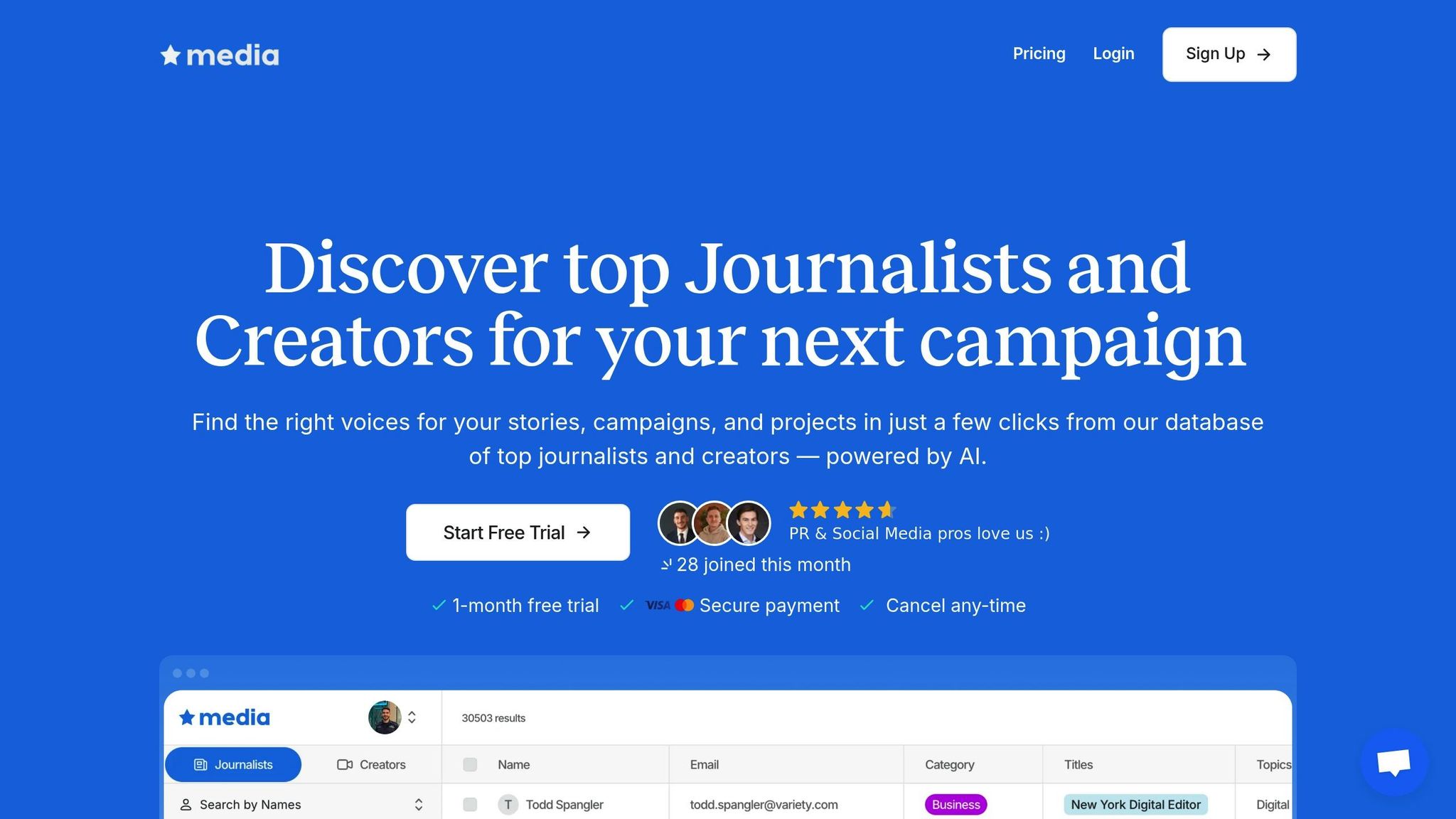
Media AI is reshaping how PR professionals approach creator campaign targeting. By combining AI-driven analytics with a robust database, it tackles long-standing challenges in influencer marketing. It’s a clear example of how AI can transform strategic goals into actionable PR outcomes.
A Closer Look at Media AI's Features
Media AI boasts a vast and regularly updated database of over 30,000 journalists and creators. Paired with AI-powered matching algorithms, it simplifies targeting by analyzing factors like audience demographics, content style, brand alignment, and past performance. This allows brands to connect with influencers who align with their goals and values.
One standout feature is the platform’s advanced search and filtering tools, which let PR professionals refine their searches based on detailed criteria. This precision is vital in an industry where 80% of marketers report improved ROI from using AI-powered matching algorithms. Traditional methods, like manually scouring social media or relying on Google searches, often consume valuable time and are prone to human error.
Media AI also enhances workflow efficiency with seamless export capabilities, enabling teams to compile contact lists and integrate them into their existing systems effortlessly. This streamlined process is a game-changer, especially when AI-powered PR tools have been shown to boost media coverage by an average of 25%.
Another critical feature is fraud detection. Using machine learning, Media AI identifies authentic engagement patterns and flags suspicious activity, addressing a major concern in influencer marketing.
Tailored for U.S. PR Professionals
Media AI is specifically designed for the U.S. market, offering pricing in USD without requiring long-term contracts. Its three-tier pricing model includes:
- Journalist Database: $99/month
- Creators Database: $99/month
- Full Database Access: $149/month
This flexible structure ensures that teams can choose options that align with their budget and campaign needs. The platform’s relevance is underscored by the fact that 87% of PR professionals believe AI will significantly impact the industry within five years. The no-contract approach also suits agile teams looking for adaptable solutions.
With an intuitive interface, Media AI enables quick onboarding, allowing users to see results almost immediately. This ease of use is critical, as companies that train employees in AI report a 43% higher success rate in implementing AI projects. By focusing on real-time, cost-effective solutions, Media AI delivers tangible benefits to U.S.-based PR teams.
Real-World Example: Media AI in Action
Imagine a U.S. tech startup launching a productivity app aimed at remote workers. Using Media AI, their PR team can filter the database to find creators who specialize in productivity content, have an audience of remote workers, and demonstrate genuine engagement.
The platform’s AI algorithms analyze historical data to predict potential ROI, helping the team prioritize outreach. Instead of spending weeks, the team identifies and contacts relevant creators within hours.
The results speak volumes. AI-generated press releases can boost lead generation by up to 25% and sales conversions by 15%. Paired with precise creator targeting, these gains become even more impactful.
Media AI’s real-time updates ensure contact details are accurate, reducing bounce rates and improving outreach success. This accuracy is crucial, as 71% of marketers emphasize the importance of understanding their audience for successful influencer campaigns.
"By eliminating repetitive, machine-like tasks, AI frees marketers to focus on what makes them truly human - strategy, creativity, and relationship-building." - Timothy Young, CEO at Jasper
Media AI embodies this philosophy by handling data-heavy tasks, giving PR professionals the freedom to focus on relationship-building and crafting impactful campaigns. It’s a forward-thinking tool that makes influencer marketing smarter, faster, and more effective for U.S. businesses.
Conclusion: The Future of AI in Creator Campaigns
AI is transforming how creator campaigns are planned and executed, making marketing efforts smarter and more effective. With the global AI market expected to hit nearly $2 trillion by 2030, the way campaigns are strategized is undergoing a major shift.
Personalization is at the heart of this change. Businesses that excel in tailoring their messaging see a 40% boost in revenue. Already, 86% of advertisers are using AI tools for personalized outreach. By analyzing massive datasets, AI algorithms can uncover consumer preferences and behaviors, enabling campaigns to connect with audiences on a highly individual level.
The benefits AI brings to PR professionals and marketing teams are game-changing. It enhances efficiency, improves accuracy, and delivers measurable returns on investment. AI-driven platforms can process vast amounts of digital content in real time, assess sentiment, and identify the best creators for a campaign. This allows teams to spend more time on strategy and creative execution.
Take Media AI as an example. With a database of over 30,000 journalists and creators, paired with advanced matching algorithms, it simplifies the process of finding the right collaborators. Its affordable pricing - starting at $99 per month for targeted databases or $149 per month for full access - makes powerful tools accessible to teams of any size, with no need for long-term commitments.
Looking ahead, the future of creator campaigns will depend on blending AI's efficiency with the creativity only humans can provide. While AI excels at analyzing data, spotting trends, and automating workflows, human insight is irreplaceable for building genuine relationships and crafting impactful stories. As influencer marketing is set to grow to $32.55 billion by 2025, those who integrate AI-driven insights and predictive tools into their strategies will be best positioned to thrive in this expanding market.
The tools are here - use AI to take your creator campaigns to the next level.
FAQs
How does AI help brands find creators who truly match their campaign goals and target audience?
AI improves how brands target creators for campaigns by using sophisticated data analysis and predictive algorithms. It examines factors like audience demographics, engagement trends, and content relevance to identify creators who best match a brand's goals. This helps ensure collaborations feel genuine while delivering impactful results.
By streamlining this process, AI eliminates much of the guesswork and saves time, enabling brands to concentrate on forming meaningful partnerships that truly connect with their audience.
How does AI identify fake followers and ensure authentic engagement in influencer marketing?
AI uses cutting-edge methods like anomaly detection, deep learning algorithms, and pattern recognition to identify fake followers and promote genuine interactions. It can pinpoint suspicious activity by examining sudden jumps in follower numbers, repetitive or off-topic comments, and inconsistent engagement patterns, distinguishing real users from bots or fake accounts.
On top of that, AI tools evaluate factors like the tone of interactions and the depth of conversations. This helps brands collaborate with creators who have meaningful connections with their audience, ensuring campaigns reach and engage real, active followers effectively.
How does AI help improve targeting and ROI in influencer campaigns?
AI plays a key role in improving influencer campaigns by using predictive analytics to anticipate outcomes, find the best creators, and spot fraudulent activity. It also delivers real-time insights, helping marketers fine-tune their strategies for greater efficiency and stronger results.
Take Media AI, for example. This tool simplifies the process by offering access to a database of over 30,000 creators and journalists. It enables PR professionals and marketers to easily find and connect with ideal collaborators. By integrating AI into their efforts, businesses can rely on data to make smarter decisions, use their resources more effectively, and boost their return on investment (ROI).


